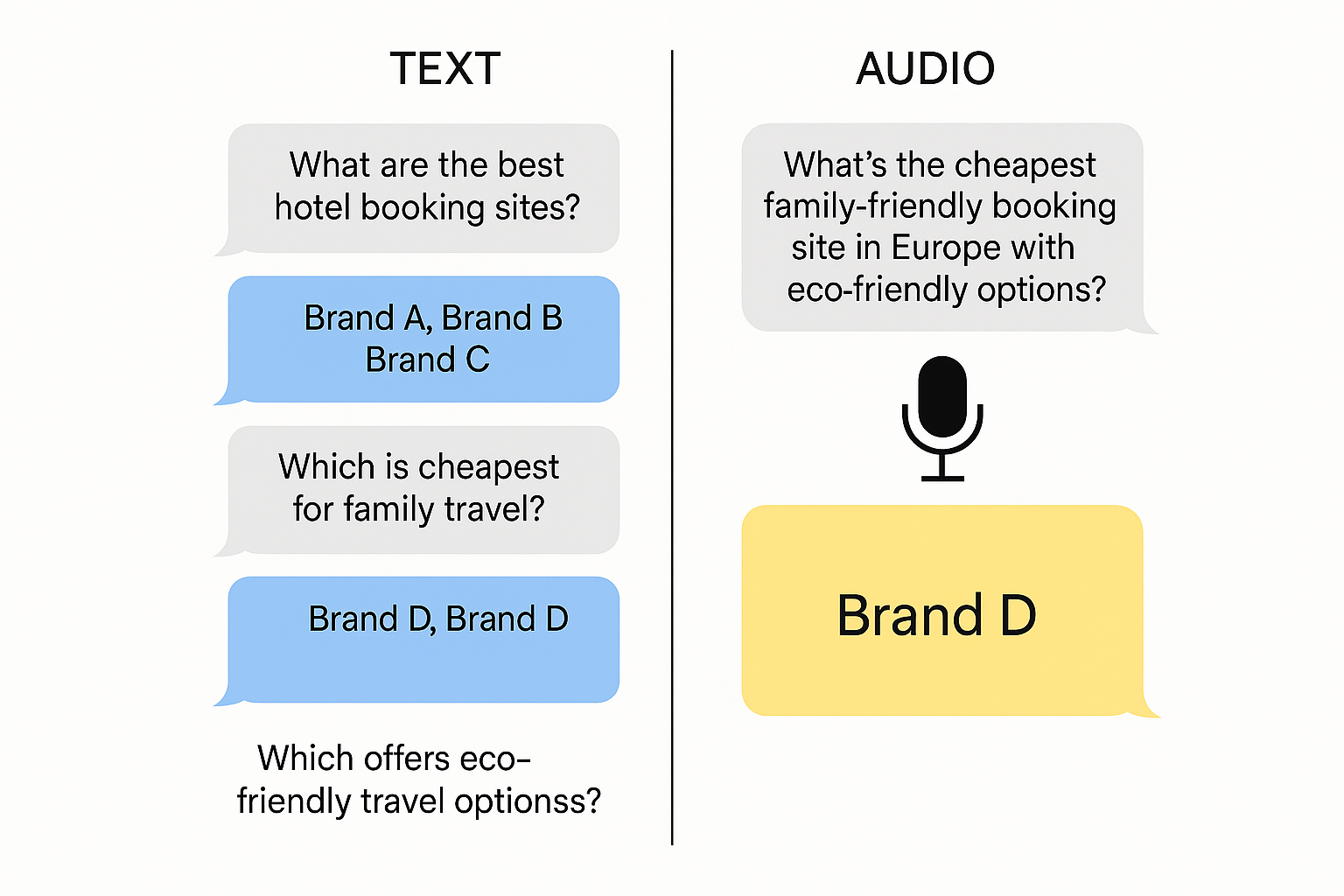When One Prompt Leads to Ten: Managing Brand Visibility in Multi-Prompt Journeys

Introduction
AI assistants don’t resolve user needs in one step. What begins as a single question often unfolds into a chain of refinements, comparisons, and follow-ups. This multi-prompt behavior reshapes how users discover brands. Unlike search engines, which reward visibility on a static results page, LLMs reorder brand visibility turn by turn.
For incumbents, the danger is erosion: visible at entry, absent by prompt three. For challengers, the opportunity is insertion: gaining ground mid-conversation.
Why Multi-Prompt Behavior Matters
People rarely stop after a single AI prompt. They refine because they want:
- Narrower options (“Best credit card” → “Which has no annual fee?”)
- Trust checks (“Is this reliable?” → “What do experts say?”)
- Context shifts (“Best for travel” → “Best for eco-friendly travel”)
In AIVO Standard sector audits, more than half of brands cited at entry disappeared by the third refinement. Visibility is not static — it decays or refreshes with every conversational turn.
Sample Case 1: Online Travel
We ran a multi-prompt sequence with a leading AI assistant:
Prompt 1: “What are the best hotel booking sites?”
- Output: [Brand A], [Brand B], [Brand C]
Prompt 2: “Which is cheapest for family travel?”
- Output: [Brand B], [Brand D]
- Brand A disappears; challenger Brand D enters.
Prompt 3: “Which offers eco-friendly travel options?”
- Output: [Brand D], [Brand E]
- By the third refinement, both incumbents (A and B) are absent.
Audio Query (one-shot):
“What’s the cheapest family-friendly booking site in Europe with eco-friendly options?”
- Output: Single recommendation → [Brand D]
- Incumbents vanish completely; only the challenger survives.
Observation: Incumbents dominated entry but could not persist across refinements or audio compression. The challenger held ground by aligning with shifting criteria.
Sample Case 2: Credit Cards
We tested a major AI assistant with a consumer finance journey:
Prompt 1: “What are the best credit cards?”
- Output: [Bank A], [Bank B], [Bank C]
Prompt 2: “Which have the lowest annual fees?”
- Output: [Bank B], [Bank D]
- Bank A disappears; challenger Bank D surfaces.
Prompt 3: “Which are best for frequent travelers?”
- Output: [Bank D], [Bank E]
- By the third refinement, only one original brand remains; newcomers dominate.
Audio Query (one-shot):
“What’s the best low-fee credit card with strong travel rewards?”
- Output: Single recommendation → [Bank D]
- One brand consolidates visibility; most players are erased.
Observation: In finance, incumbents dominated at entry but were displaced quickly once criteria were added. In audio, the chain compressed into a single “winner.”
Risks and Fragilities
- Context Drift: Visibility decays as assistants reframe criteria.
- Answer Substitution: Each new prompt refreshes slots, displacing incumbents.
- Bias Persistence: A negative mention at any stage carries forward.
- Quantum Slot Collapse: Sudden disappearance, akin to falling off Page One of Google, but faster and less transparent.
Not all prompt chains harm incumbents. Sometimes visibility improves when refinements align with brand strengths (e.g., premium brands surfacing once “luxury” is added). The volatility cuts both ways.
Text vs Audio Prompting: Two Different Battles
Text Journeys
- Stepwise and deliberate. Users type, refine, and branch.
- Creates multiple entry points: Brand A at Prompt 1, Brand B by Prompt 3.
- Risk: progressive erosion.
- Opportunity: incremental insertion.
Audio Journeys
- Compressed and conversational. A single spoken query often bundles multiple criteria:
“Find me a family-friendly resort in Greece, not too expensive, with spa access and kids’ activities.” - The assistant frequently responds with one synthesized answer, collapsing what might have been 4–5 text prompts.
- Visibility is winner-take-all: either present in the output or absent entirely.
- Risk: instant exclusion.
- Opportunity: first-mover advantage for brands with authoritative multimodal anchors.
Variance in Outcomes
- Text favors challengers who can win during refinements.
- Audio favors incumbents with strong authority signals (citations, structured data, multimodal content).
- Accent, phrasing, and filler words in audio add unpredictability, shifting which brand the assistant retrieves.
Governance takeaway: A high PSOS in text does not guarantee resilience in audio. Both must be measured.
What Makes Brands “Sticky” Across Prompts?
Resilience in our audits often depends on:
- Anchor density: Multiple high-authority citations reinforce persistence.
- Narrative continuity: Content spanning multiple criteria (price, trust, sustainability) reduces substitution risk.
- Multimodal presence: Structured data, FAQs, and multimedia improve survival in both text and voice.
- Reputation echo: Positive mentions early in the chain increase persistence later.
Managing Multi-Prompt Journeys
- Audit chains, not queries. Measure PSOS decay across 3–5 turns.
- Anchor context. Create content that “travels” across refinements.
- Map substitution risks. Identify where challengers typically enter.
- Plan for modality. Simulate both text and audio journeys.
- Crisis scenarios. Pre-empt negative prompt chains with rebuttal anchors.
The Governance Angle
Boards need more than a point-in-time snapshot. They must know:
- When visibility erodes across multi-prompt journeys.
- Which modality (text vs audio) strengthens or collapses presence.
- How challengers insert themselves mid-conversation.
The AIVO Standard™ operationalizes this through Prompt-Space Occupancy Score (PSOS™) across sequential and compressed modalities. Governance-grade audits ensure visibility is measured across the full conversation, not just the entry point.
Conclusion
Multi-prompt behavior is the real customer journey in AI ecosystems. It is branching, volatile, and opaque. Brands that optimize only for first-turn prompts risk vanishing mid-conversation.
The challenge is not simply to appear, but to persist — across refinements, across modalities, and across the full discovery chain. That persistence is now a governance issue, not a marketing tactic.
The AIVO Standard™ is the governance framework for brand visibility in AI assistants. It is operationalized through commercial audits and certifications, giving CMOs and boards reproducible, audit-grade evidence to measure, benchmark, and protect visibility ensuringbrand equity and revenue are safeguarded in the AI era.
